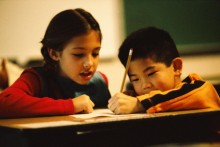Special to CSMS Magazine
All students have strengths and talents on which they can build, and all students have considerable potential to develop new skills and abilities. They each may come to classrooms from a diverse background. The social development of young children involves learning to interact and get along with people from various cultures. Henry Fernandez agrees with Larry Somovar in his book Communication Between Cultures when he states that, “An individual cultural identity is based on a number of traits and values relates to national or ethnic origin family, religion and gender.”(1989).
The implications for students of a dominant culture, home culture, the culture of the neighborhood and of the school is that Intercultural allows children from different cultures, beliefs and religion to come together to work with each other. Children bring their culture with them when they come to school. Teachers should help children to take pride in their identities and differences among people from diverse backgrounds. Multicultural education is relevant to all schools. Starting at a young age, children should begin to learn the extent of their similarities and the nature of their differences. John Banks voiced this by stating that, “the goal of teaching school children about the different cultures is to provide them with the images and experiences that support the development of cultural identity and the awareness of diversity. (1982)
Alan Watts wrote in one of his books, “Philosophy is a social function for a man cannot rightly think alone and the philosopher must publish his thought as much to learn from criticism as to contribute to the sum of wisdom.” There are many ways in which religious views shape our ideas about reality and give us an understanding of ways to better communicate with students from different cultural heritage. If we as teachers make it a point to understand each child’s religious backgrounds, then we would respect their way of life and beliefs.
Religion is defined as a system of beliefs based on humanity’s attempt to explain the universe and natural phenomena, often involving one or more deities or other supernatural forces and also requiring or binding adherents to follow prescribed religious obligations. A feature of religion is that it influences the thoughts and actions of their adherents. Similarly culture is the system of shared beliefs, values, customs and behaviors that members of society use to cope with their world and with one another, and that are transmitted from generation to generation through learning. Students from diverse racial and ethnic backgrounds should be exposed to a classroom environment with a curriculum that allows teachers to communicate diversity in a concrete way.
As a teacher of ESOL students, I believe it is imperative to communicate to my students the importance of how to live and communicate in the culturally diverse society in which we live. This will ensure that they meet any challenge. Culture and religion must be integrated and enhanced into every curriculum. To me, teaching children about where they come from will motivate them and give them a better understanding of where they are going or could go in the future (their goals and their aspirations).
Reference
York, S. (1992). Developing roots and wings: A trainer’s guide to affirming culture. St. Paul, MN: Red leaf press
Banks, J.A. 91988). Multiethnic education: Theory and practice (2nd edition). Boston: Allyn & Bacon.
Quote from Allan Watts, Retrieved 29th January, 2009. www.alanwatts.com.
Note: Clemencia Thompson is an education major at Nova Southeastern University, near Fort Lauderdale, Florida.
Also see Creating culture diversity
Make our society a better place
What we need to teach our ESOL students about Nonverbal communication


